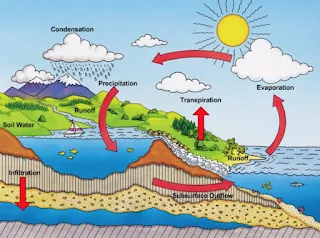Discuss various factors which affect the variation in the climate of a place?
 |
| Various factors which affect the variation in the climate of a place. |
The climate of a place is
influenced by a multitude of factors, both natural and human-induced. These
factors can interact in complex ways, leading to the variation we observe in
different regions around the world. Here are some of the key factors that
affect climate variation:
- Latitude: Latitude plays a
significant role in determining climate. Places closer to the equator
receive more direct sunlight throughout the year and tend to have a warmer
climate. In contrast, regions near the poles receive less direct sunlight
and are generally colder.
- Elevation
(Altitude): Higher elevations experience cooler temperatures. As air
rises, it expands and cools, resulting in a decrease in temperature with
increasing altitude. Mountainous regions, even those near the equator, can
have colder climates due to their elevation.
- Proximity to Water Bodies:
Oceans, seas, and large lakes have a moderating effect on the climate of
nearby land areas. Coastal regions experience milder and more stable
temperatures compared to inland areas because water has a higher heat
capacity, which helps regulate temperature changes.
- Ocean Currents:
Ocean currents, driven by wind patterns and temperature differences, can
significantly influence the climate of coastal regions. Warm ocean
currents can raise temperatures, while cold currents can cool down nearby
areas.
- Prevailing Winds:
Wind patterns can carry air masses from one region to another, affecting
temperature and precipitation patterns. For example, winds blowing from
oceans can bring moisture and contribute to increased rainfall in coastal
areas.
- Topography:
The shape of the land and its features, such as mountains, valleys, and
slopes, can influence local climate. Mountains can block or redirect air
masses, leading to variations in rainfall and temperature on different
sides of the mountain range (rain shadow effect).
- Air Masses and Fronts:
The movement and interaction of air masses and fronts can lead to changes
in weather patterns. Warm fronts bring milder conditions, while cold
fronts can trigger cooler and more turbulent weather.
- Greenhouse Gases:
Human activities, such as burning fossil fuels and deforestation, have
increased the concentration of greenhouse gases in the atmosphere. This
leads to the greenhouse effect, trapping heat and causing global warming,
which, in turn, affects regional climates.
- Solar Radiation:
Variations in solar radiation due to changes in the Earth's orbit, tilt,
and solar activity can cause long-term climate variations, such as ice
ages and interglacial periods.
- Land Use Changes:
Human activities that alter the landscape, such as urbanization and
deforestation, can affect local climate patterns. Urban areas often have
higher temperatures (urban heat island effect) compared to rural
surroundings.
- Climate Change:
Long-term changes in the Earth's climate due to natural factors and human
activities can also cause variations in regional climates over time.
It's important to understand
these factors and their interactions to predict and adapt to climate
variations, as well as to address the challenges posed by ongoing climate
change.
Tags:
GSA
